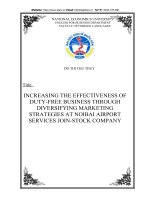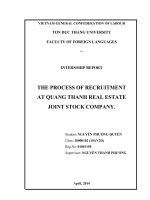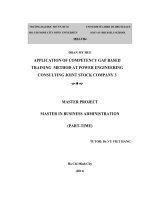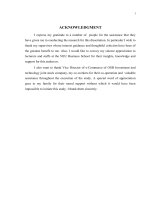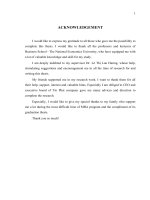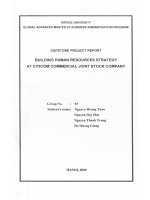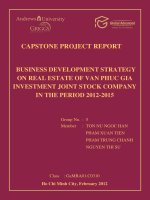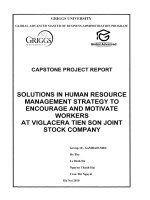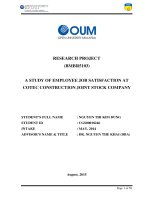Ineffective cost budgeting process at phuc dat land joint stock company
Bạn đang xem bản rút gọn của tài liệu. Xem và tải ngay bản đầy đủ của tài liệu tại đây (10.45 MB, 62 trang )
UNIVERSITY OF ECONOMICS HO CHI MINH CITY
International School of Business
------------------------------
LE THI KIM DUNG
INEFFECTIVE COST BUDGETING
PROCESS AT PHUC DAT LAND JOINT
STOCK COMPANY
MASTER OF BUSINESS ADMINISTRATION
Ho Chi Minh City - 2017.
UNIVERSITY OF ECONOMICS HO CHI MINH CITY
International School of Business
------------------------------
LE THI KIM DUNG
INEFFECTIVE COST BUDGETING
PROCESS AT PHUC DAT LAND JOINT
STOCK COMPANY
MASTER OF BUSINESS ADMINISTRATION
SUPERVISOR: TRAN PHUONG THAO
Ho Chi Minh City - 2017.
SUPERVISOR’S REPORT ON THE FINAL THESIS SUBMITTED
FOR THE DEGREE OF MASTER OF BUSINESS ADMINISTRATION
Final thesis title: ..............................................................................................................
.........................................................................................................................................
Student name: ...................................................................................................................
Supervisor name: .............................................................................................................
1. General comments:
Remarks on the student’s attitude:
.......................................................................................................................................
.......................................................................................................................................
Remarks on the assignment’s academic quality:
.......................................................................................................................................
.......................................................................................................................................
2. Overall assessment:
Meet requirement for submitting;
Not meet requirement for submitting.
3. Other remarks:
- Did the student follow the report schedule?
Yes
No
- The Turnitin plagiarism percentage:
Supervisor’s signature
Other ....................................................
ACKNOWLEDGEMENTS
I would like to acknowledge all who supported me during my studies without whom
my thesis could not be completed in a proper way.
I would especially like to thank my supervisor – Professor Tran Phuong Thao for all
her advice and guidance, without her help I could not have my thesis done in the right
way.
I also would like to show my dedication to my colleagues at work for their continuous
support. I also send my sincere thankfulness to my parents and friends for their care,
support and encouragement.
TABLE OF CONTENTS
ACKNOWLEDGEMENTS ....................................................................................................................
LIST OF FIGURES.................................................................................................................................
LIST OF TABLES ..................................................................................................................................
EXECUTIVE SUMMARY ....................................................................................................................1
1.
2.
3.
PROBLEM CONTEXT .................................................................................................................2
1.1.
Background of Phuc Dat Land Joint Stock Company ........................................................2
1.2.
Symptoms of the problem ......................................................................................................3
1.2.1
Significant gaps between actual and budgeted expenses ............................................3
1.2.2
Late completion of Budgeting in 2017 ..........................................................................4
PROBLEMS IDENTIFICATION ................................................................................................5
2.1
Situation analysis ....................................................................................................................5
2.2
Potential problems..................................................................................................................9
CENTRAL PROBLEM VALIDATION ................................................................................... 13
3.1
Identification of the Central problem ................................................................................ 13
3.2
Central problem definition ................................................................................................. 16
3.3
The importance of the problem.......................................................................................... 19
4.
CAUSE VALIDATION .............................................................................................................. 19
5.
ALTERNATIVE SOLUTIONS AND ACTION PLANS ........................................................ 25
5.1
The first solution: Build a clear process and schedule for exchange information among
departments ..................................................................................................................................... 25
5.2
The second solution: Training for manager and assistant manager levels .................... 31
6.
CONCLUSION ............................................................................................................................ 33
7.
SUPPORTING INFORMATION .............................................................................................. 34
8.
7.1
Summary of Methodology conducted ................................................................................ 34
7.2
Interview guide .................................................................................................................... 37
7.3
Transcripts ........................................................................................................................... 39
7.4
Transcript summary ........................................................................................................... 49
7.5
Cost comparison Reports in 2015 and 2016 ...................................................................... 52
7.6
Questionnaires ..................................................................................................................... 54
REFERENCES ............................................................................................................................ 56
EXECUTIVE SUMMARY
As the economy dramatically grows up, companies are competing fiercely to
survive and contribute to that development. Generating revenue is always an
important issue in business plans that every entrepreneur pays much attention to
aim at maximizing profits. However, nowadays, cost management also plays an
important role in the business and budget has become a necessary activity of any
organization for the purpose of well-controlled expenses to maximize its benefits.
Without a proper budget, a business can hardly keep track of how much it has
earned and how much it has spent to meet its shareholders’ expectations related
to profits and the organization’s goals.
This thesis aims to explore the causes of significant variance between budget and
actual financial results in 2015, 2016 and the late completion of budget in 2017 at
Phuc Dat Land Joint Stock Company (“the Company”). In-depth interviews were
conducted to generate the understandings from highly responsible positions about
budgeting at the Company and figure out the central problem related to
Budgeting. The findings of this study revealed that ineffective cost budgeting
process tends to play a significant issue in the matter of budget engagement and
leads to the difficulties in finalizing budget on target timeline. The findings are
discussed in details in the research along with some recommendations for the
company and management to improve the budgeting process and cost
management ability to get better results which directly affects departments’
performances evaluation and the whole company’s in general.
Page | 1
LIST OF FIGURES
Figure 1: Phuc Dat Land Joint Stock Company structure ...........................................2
Figure 2: Initial Cause – effect Map ........................................................................ 12
Figure 3: Final Cause-effect Map ............................................................................ 21
Figure 4: Meeting schedule for Budget preparation at Phuc Dat Land ................... 29
Figure 5: Respondents information: Gender, Working years, Level, Department
classification at Phuc Dat Land. ............................................................................... 36
LIST OF TABLES
Table 1: Phuc Dat Land Actual and Budget Cost in 2015 ..........................................3
Table 2: Phuc Dat Land Actual and Budget Cost in 2016 ..........................................3
Table 3: Cost structure in Budget of Phuc Dat Land Joint Stock Company...............5
Table 4: Significant differences in % between Actual and Budget data .....................6
Table 5: Level of factors affect budgeting process at Phuc Dat Land ..................... 23
Table 6: Estimate cost for budget skill training organized by Smarttrain center for
Managers and Assistant Managers at Phuc Dat Land .............................................. 32
Table 7: Summary information of respondents of first In-depth interviews ........... 39
Table 8: Summary information of respondents of second In-depth interviews ...... 44
Table 9: Phuc Dat Land Actual and Budget Cost in 2015 ....................................... 52
Table 10: Phuc Dat Land Actual and Budget Cost in 2016 ..................................... 53
1.
PROBLEM CONTEXT
1.1. Background of Phuc Dat Land Joint Stock Company
Established in 2013, Phuc Dat Land Joint Stock Company is a company
operating in real estate industry, major in leasing office building in Ho Chi Minh
City. It belongs to Son Kim Group which is one of the most successful
corporations in this industry. The Company mains business is leasing Empress
Tower Building at 138-142 Hai Ba Trung, District 1, Ho Chi Minh city with 17
floors and its revenue is nearly 170 billion VND per year.
As the company operates under the control of Son Kim Group, it has to follow
the performance management from Head office (“HO”) with approved Budget
and KPI set by BOD. This is also agreed by the Investors from EXS Capital – an
investment fund from Hong Kong who has invested for most of Son Kim Group
projects including Empress Tower Building.
The operation of the Company does not fluctuate much as the stable number of
lessees. However, cost through years have been changed due to the demand of
maintenance and renew the building to increase the quality of its service.
There are four main departments in which are under controlled of BOD. The
company’s structure is drawn as following chart:
Board of
Directors
Accounting
department
Property
management
Operation
control
Internal
Security
Sales &
marketing
department
Leasing
Technical
department
Human
resources
Marketing
Figure 1: Phuc Dat Land Joint Stock Company structure
(Source: Human Resources Department of Phuc Dat Land)
Page | 2
1.2. Symptoms of the problem
1.2.1 Significant gaps between actual and budgeted expenses
P&L comparison between Actual and Budgeted Revenue, Operating expenses
and EBITDA reports of Phuc Dat Land in 2015 and 2016 are showed as below
(shortened version showed) which reflected the operation results of the Company
in these two years. It was not a bright picture as there were many issues need
improving.
2015
Actual
Budget
Variance
Amount
%
Gross Revenue
158,027,699,003
159,209,516,144
-1,181,817,141
-1%
Operating
expenses
115,299,557,251
107,184,342,908
8,115,214,343
8%
EBITDA
42,728,141,752
52,025,173,236
-9,297,031,484
-18%
Table 1: Phuc Dat Land Actual and Budget P&L in 2015 (Unit: VND)
(Source: Phuc Dat Land Profit and Loss 2015 report)
2016
Actual
Budget
Variance
Amount
%
Gross Revenue
169,177,516,286
167,588,373,520
1,589,142,766
1%
Operating
expenses
124,516,336,035
116,220,033,417
8,296,302,618
7%
EBITDA
44,661,180,251
51,368,340,103
-6,707,159,852
-13%
Table 2: Phuc Dat Land Actual and Budget P&L in 2016 (Unit: VND)
(Source: Phuc Dat Land Profit and Loss 2016 report)
It indicated that there was significant difference between actual and budgeted in
operating expenses. Operating expenses includes COGS, Selling and G&A
expenses which are presented above in the format of management accounting
reports of the Company. Revenue did not fluctuate much as there were very little
differences between actual and budgeted amounts (around 1%) due to the stable
income sources coming from loyalty customers who have signed leasing
Page | 3
contracts for over 5 years. Revenue stayed stable but cost differed from what had
been budgeted a lot led to the fact that actual EBITDA in both years were much
lower than Budget.
1.2.2 Late completion of Budgeting in 2017
According to Budgeting schedule sent out by Finance Department from Son Kim
Group, 2017 Budget must be finalized at the end of 2016 to prepare business plan
for up-coming year. However, the Company did not meet that compulsory
deadline.
Budget for 2017 has not been finalized until the end of June 2017 after many
revised versions. This information was obtained from Ms. Vy Oanh – Chief
accountant (CA):
‘Budget of 2017 was revised many times. Targets sent out by the BOD were
presented in many versions. I even did not remember which the last one was
until it was updated into the company’s system for final records. And after
about 8 months, the final budget was approved by the BOD on June, 2017.’
This information was confirmed by Mr. Dung Tran - Head of Finance and
Accounting Department of Son Kim Group.
‘2017 is the third year Son Kim Group applying Budget in Management
Control and Performance evaluation. Therefore, there were still some
deficiencies in the experiences and processes that led to the fact that it took
months to complete the Budget. This came from objective and subjective
factors that we tried to deal with but still behind schedule.’
Actually, budgets of 2015 and 2016 were also behind the schedule. In 2015, this
was the first year the company applied Budgeting in management activity that it
took around ten months to get used to the model and to build up a complete
budget. In 2016, the situation was improved but still under expectation that it
Page | 4
took more than seven months to finalize approval budget for the fiscal year. 2017
was also an unsuccessful year of Budgeting at Phuc Dat Land.
2.
PROBLEMS IDENTIFICATION
2.1 Situation analysis
Variance analysis in Cost budgeting
Concentrating on operating expenses, we need to understand the cost structure of
the Company first. Each department of the Company is a cost center which is
responsible for expenses allocated by their characteristics activities. The Cost
structure of the Company is presented as following:
No.
1
2
3
4
5
Type of expenses
Personnel and related expenses
Repair and maintenance
Building management
Marketing & Commission
Other operating expenses
Department in charge
Human resources
Technical department
Property Management
Sales & Marketing
Accounting department
Total
% in total Operating
Cost
2015
2016
8%
9%
19%
18%
67%
66%
1%
1.5%
5%
5.5%
100%
100%
Table 3: Cost structure in Budget of Phuc Dat Land Joint Stock Company
(Source: Accounting Department of Phuc Dat Land)
This table shows the percentage of expenses under control of each department in
the total budgeted cost of the Company in two years 2015 and 2016. The building
management expenses accounts for the highest portion in total cost followed by
Repair and maintenance expenses belongs to Technical department while
Marketing and Commission fee stays lowest. Cost portion of each type of
expenses remained stable among years according to the company’s perdurable
operation.
This cost structure helps author in clarifying the problem related to significant
differences in cost between actual and budgeted amounts and the control of
expenses of Phuc Dat Land by reviewing in detail each type of expense and
looking for the most fluctuated ones.
Page | 5
At Phuc Dat Land, revenue and costs are budgeted for every fiscal year which is
known as KPI of the Company in Son Kim Group. Based on this, the Company
performance will be evaluated at the end of the year. Each department is
allocated to be responsible for each type of revenue or expense and the criteria to
evaluate their performance is the actual result compared to budgeted amount.
Therefore, the effectiveness of each department in revenue push-up or cost
controlling will affect the whole company KPI result at the year-end.
Variance in costs is a big issue of the company currently. From the Cost
comparison reports show in section 7.5, author has summarized some significant
variances between actual and budgeted expenses in below table:
Type of Expenses
2015
2016
Cleaning fee
24%
6%
Service fee
33%
31%
Repair and maintenance
35%
22%
Technical materials
Renovation
39%
70%
28%
54%
Table 4: Significant differences in % between Actual and Budget data
(Source: Phuc Dat Land Profit and Loss 2015, 2016 Budget report)
The most differences came from the expenses under control of Technical
department such as Technical materials, Repair and maintenance or Renovation.
The differences between actual and budgeted costs have been improved in 2016
compared to 2015; however, over 20% actual expenses much higher than
budgeted were unacceptable for the company performance evaluation in Son Kim
Group. For example, actual Renovation expense in 2015 was 70% much higher
than budgeted amount while in 2016 this gap was reduced but still remained high
at 54%. Technical Materials or Repair and maintenance costs in 2015 were over
35% actual higher than budgeted and also were reduced in 2016 but this year
recorded the percentage of over 20%. Other remarkable items came from costs
under control of Property management; however, they had been improved
significantly in 2016 such as Cleaning fee (down from 24% in 2015 to 6% in
2016) or Security expenses (down from 38% actual lower than budgeted to 12%
Page | 6
much higher in two years). Many meetings were organized to find out the
reasons and gather ideas in dealing with this issue but it is still a big question to
management team of the Company.
An investigation in Cost budgeting
It is important to figure out the reasons for the significant differences between
budget and actual costs at Phuc Dat Land Joint Stock Company and the late
completion of fiscal year 2017 Budgeting as mentioned above. After examining
many relevant literatures, the potential antecedents that are believed to provide
the most understanding are Head of accounting department and Head of
functional departments.
Two in-depth interviews with responsible persons including Chief accountant
(CA) and Manager of Technical department were conducted to generate an
overview on Budgeting at Phuc Dat Land.
Per interview Ms. Vy Oanh – CA, there are some main points identified related
to problems of budgeting at the company. She explained why there were so many
differences in expenses allocated for each department.
According to her, even costs under control of Building management take the
largest part in total cost of the company but it seemed to have fewer variance
between actual and budgeted amounts. This was due to the stable of the Leasing
building that some expenses such as asset rental, security expenses, cleaning
expenses, customers’ relationship and other operation expenses for the building
stayed stable and nearly the same as budget which was built based on services
contracts with suppliers. The Technical department takes responsible for the
second largest part in the cost structure of the company. However, there were
many unplanned events happened during the year such as power system failure,
major repair of several floors or replacement of some old equipment that caused
more cost in their approved budget. Besides, some targets set by BOD were
much different from initial budget prepared by departments that they had to
adjust but did not totally match with their activities. They had communicated this
Page | 7
problem with BOD, however, due to the analysis from business plan for the
whole group that the limitation was set.
When being asked about budgeting process, she indicated that there was no clear
process in Budgeting. They usually did it based on their own experience. Head
office sent out the timelines and deadlines for Budget to each subsidiary that they
need to follow. Heads of department did not ask for actual data from previous
years from Accounting department for next year budgeting but based on their
current status. It appeared weak interaction among departments during the
Budgeting period. Ms. Vy Oanh – Chief Accountant shared that:
‘I think it’s also due to the whole process that there’s no clear steps identified.
We just prepare Budget base on our experience rather than complying with
any cycle or guidance. And as consequence, departments fail to connect with
each other for sharing information in the process of building budget.’
Budget of 2017 took long time to be finalized due to the change of KPI set by
Group and sent out to the Company as 2017 is an important year calling for
investment for many new real estate projects of Son Kim Group. Besides, the
timeline had been changed continuously that it was hard for the company to catch
up with.
After that, an interview with Mr. Bao Dang – Head of Technical department
which had most problems in actual and budget figures was conducted to validate
and update more information for the study. The matter of communication with
accounting department was raised. He responded that every quarter, accounting
department sent out actual figures to his department so that he could cross check
with his records and explain the variance to BOD. Therefore, based on these
reports and his department’s action plan, he made budgeting for the up-coming
fiscal year. However, if there’s any change in number, he would not be noticed
by accounting department.
Another discussed issue was the Targets from BOD. According to Mr. Bao Dang,
targets set by BOD on some items were too low that he could not adjust and
Page | 8
control expenses within the limitation such as technical materials which were
purchased every quarter for maintenance purpose. In addition, unplanned events
happened out of his department control due to the late communication from
Building management department about problems at Lessee’s areas for timely
repair to reduce the cost due to larger issues.
The budgeting process took much time and required detail information for
forecasting to ensure the accuracy. At Phuc Dat Land, 2015 was the first year
budget had been applied and most of Departments leaders had little experience in
this field. He was not familiar with accounting data and there was no official
training for the budgeting preparation for him to understand the whole process
and the tools for collecting proper data. Besides, there’s no clear procedure and
communication between related departments that he felt it difficult to complete
the budget at appointed time.
Referring to the cost control, during the operation, he kept track for expense by
an excel file with detailed budget by cost center allocated for his department.
When reviewing the file at the end of each month, any abnormal issues would be
raised to his employees to find out the reasons and alert for the expenditure
spending. However, he was not noticed for the abnormal issues due to unplanned
events that out of his department control due to late communication with other
departments.
2.2 Potential problems
From the interviews with person who is responsible for budgeting in Phuc Dat
Land and the one who is in charge of finalizing the budget to submit to BOD,
some key points were identified to draw a picture of potential problems related to
cost budgeting issues at the Company. Main ideas are summarized in the
transcripts summary in section 7.4. Based on these key points from the first two
in-depth interviews and author’s observation, potentials problems related to the
significant different between actual and budgeted expenses and the late
completion of 2017 Budget are identified as following:
Page | 9
Unrealistic goals set for the budget: two interviewees (Ms. Vy Oanh – CA
and Mr. Bao Dang – Head of Technical Department) agreed that some targets
set by BOD were much different from initial budget prepared by departments
that they had to adjust their cost with limited resources. This caused the
inaccuracy in operation planning and was the reason leading to the significant
differences between actual and budgeted expenses. At Phuc Dat Land, budget
is prepared based on a mixed manner by combining bottom-up approach and
top-down approach. In this method, targets are still set by BOD and sent out to
each department to adjust to match with their activities but all were under
controlled of BOD’s goals. They also mentioned that 2017 was an important
year of Son Kim Group to call for investment as there were many new real
estate projects which accounted for a huge capital to build up; therefore, BOD
had revised KPI, which was built based on Budget for each company, many
times to ensure the whole Group performance plan must be as good as
possible to present to strategic investors. As a consequence, it took longer time
to revise the budget and the schedule had been changed accordingly.
Ineffective cost budgeting process: those points mentioning about unplanned
events happened, no clear steps, budgeting experience or little connection
among departments are gathered in one general problem called as ineffective
budgeting process as they are related to the whole budgeting cycle. The two
interviewees were all not clear of the cost budgeting process at the Company.
They agreed that there were unclear timeline for budgeting (as mentioned
above that had been changed many times) and so a few tools for collecting
data that managers lacking of experience in budgeting could not complete the
proper budget without forecasting future events due to no clear guidance from
Head office Finance team was released. They were just noticed about the
deadlines for submitting their budget. Besides, communication between
related departments was an obstacle to the budget preparation and
performance control. The Manager from Technical department emphasized
that there was poor connection between his department and others due to the
busy time that it was hard for them to gather or conduct meetings together on
Page | 10
Budgeting season. Budgeting process is a big issue to deal with in order to
make an effective budget for the Company.
Weakness in expenses spending control: Cost is controlled daily and
reported monthly by deputy manager to Head of department. However, alert
for significant issues before reviewing the control files was not raised until
abnormal issues rose that managers reviewed their budget to check the
variance between actual and budget to find out reasons and ways to adjust or
explain to Management level. Problem in cost control may lead to the
ineffectiveness of expenses spending control and inevitably lead to the
variance in budgeted and actual amount.
From all the points summarized above, the initial MAP for Cost Budgeting
problem at Phuc Dat Land is developed with three main potential problems and
some potential causes leading to these problems as following:
Page | 11
Figure 2: Initial Cause - Effect Map
Page | 12
3.
CENTRAL PROBLEM VALIDATION
3.1 Identification of the Central problem
In order to validate those potential problems identified in 2.2 and find out the
central problem led to the significant variance between budget and actual figures
at Phuc Dat Land, another in-depth interview with Mr. Dung Tran - Head of
Finance department from Son Kim group was conducted.
Per discussing with Mr. Dung Tran, author noted that budget set by BOD sent
out to Phuc Dat Land was based on previous year data and development business
plan for next fiscal year. Meetings were conducted between Finance Team and
Phuc Dat Land’s head of departments to discuss about the final budget. However,
as the target set by BOD but also under pressure of investors, the final budget
would be affected accordingly. Revenue would be higher than budgeted amount
sent out by Sales & Marketing department and some expense items would be
lower than original amount sent out by other Head of departments. Operations
teams had to control their actual cost well to minimize the expenses incur and
meet the targets. Besides, budget was set to evaluate the company’s performance;
they aimed to set a little bit higher revenue or lower expenses to make sure
employees try their best to acquire the highest results with available resources.
This was built by setting revenue with maximum leasing capacity and cutting
down some redundant expenses which were not used in prior years. This is
applied for whole group, not only Phuc Dat Land, therefore, author did not
investigate more in this potential problem.
However, when talking about the timeline for budgeting and guideline from HO
for the budget preparation to each project, he just mentioned the general
procedure. There was no detail plan from HO for budgeting. The timeline was
sent out but revised many times and delayed due to changes from BOD.
Managers at each company had to prepare the budget themselves and send out to
accounting department for summarizing and finalizing. He understands the
difficulties for them in budgeting process but due to the requirements from BOD
Page | 13
that there was not much better among years. In 2015, the process took ten months
to finalize the budget and seven months for 2016. In 2017, the situation had not
been improved much as it even took more than seven months to complete.
When being asked about the significant differences between budget and actual
Profit and lost reports in 2015, 2016, he showed out that the total revenue or total
cost was not much that variance (and actually they were just around 1% for total
revenue – and 7 to 8% for expenses), only detail accounts appeared that matter.
BOD had required head of departments to explain for those differences and the
matter was notified to appear from the detail cost budget controlled by each
department. Most of explanations for those differences were due to the weakness
in planning that many unplanned events happened out of departments’ control
that caused more expenses spending. The problem came from detail items must
be investigated more in order to find out whether the budgeting issue came from
this field.
After gathering information provided by Mr. Dung Tran and from the first two
in-depth interviews in the Potential problems identification part, another
interview with Mr. Quang Pham – Head of Property management was conducted.
Property management department is responsible for over 65% of total expenses.
However, his department did not stand for many significant differences in
budgeted and actual expenses thanks to the stable of operation in leasing
business. During the first part of this thesis, author has mentioned a lot about cost
budgeting process; hence, couple of questions related to this issue had been
raised to this Manager. Mr. Quang Pham shared that he was not noticed about
any procedure before preparing budget. Only the timeline was sent out to all
managers but changed many times due to the revised KPI sent out by BOD for
each department to adjust their budget. He also indicated that sometime he did
not understand all the requirements from BOD such as which items should be
adjusted, which items should be cut down that he failed to adjust his department
budget according to BOD change in targets and had to revise many times. Hence,
his department’s budget was sent out and received back for revising constantly.
Page | 14
Besides, the interaction with other related departments such as Technical
department did not happen due to the busy period for each department to
complete their budgets and other operation tasks. He mentioned that only one or
two meetings were conducted for the Budgeting announcement and Budgeting
finalization. During the budgeting period, no meeting was hold for exchanging
information or providing sufficient ideas to complete budget at expectation level.
Then most of his forecasting was made based on the services contracts signed
with suppliers and reports from staff. Budget was made based on managers’
experience rather than collecting information from external and internal factors.
Therefore, if there was any change in the cost from suppliers, budget would be
adjusted or lead to the variance between actual cost and budget cost. He also
admitted that as budgeting has just been applied from 2015, most of managers
have little experience in this area but no training or guidance from HO Finance
team was provided.
About the cost management, expenses are followed up by an excel file with
detailed budget by cost center allocated for his department. When reviewing the
file submitted by his assistant manager at the end of each month combining with
Management reports sent out from accounting department, any abnormal issues
would be raised to his employees to find out the reasons and alert for the
expenditure spending. This helps him to control his department budgeted costs
versa actual in order to keep track on their spending and meet the KPI allocated.
Therefore, expenses are still controlled in acceptable area.
Main ideas from these two interviews are summarized in section 7.4. Combining
information from interviews with manager levels at Phuc Dat Land and author’s
observation, the significant difference between budget and actual cost came from
the ineffective cost budgeting process. This happened from the beginning that
requirements from BOD had not been fully understood. The process was
conducted without clear steps and allocated tasks for each department or
responsible person to gather them in the cost budgeting process so that they could
build up a strong connection among departments by exchanging data for
Page | 15
forecasting future events related to their operations. Moreover, unclear timeline
for the process was an obstacle for managers to complete their budget with high
quality results.
It is essential to build up a proper cost budgeting process to drive both
company’s goals and fiscal accountability for coming to a good budget.
3.2 Central problem definition
Elizabeth Hamilton Foley (3) stated that:
‘The budget process is the way an organization goes about building its budget.
A good budgeting process engages those who are responsible for adhering to
the budget and implementing the organization's objectives in creating the
budget. Both finance committee and senior staff participation is built into the
process and a timeline is established leaving adequate time for research,
review, feedback, revisions, etc. before the budget is ready for presentation to
the full board.’
According to Jacqueline Birt (1), the budgeting process involves seven steps:
Evaluating past performance
Assessing and incorporating expectations
Preparing estimates
based on communication with and feedback from
managers
Preparing budgeted reports
Monitoring actual performance
Making adjustment as required by changing circumstances. (p382)
Elizabeth Hamilton Foley (3) also indicated that “The annual budgeting process
should be documented, with tasks, responsibility assignments and deadlines
clearly stated.” He also argued that the step of communicating with managers
who are affected by the budgets should occur as they are mostly knowledgeable
about their divisions or departments based on which budget will be prepared.
Page | 16
Besides, in the budget processes, monitoring actual performance accounts for an
important role to keep track with approved budget and also to evaluate the
operation of the organization toward strategic objectives.
In general, the Budgeting process can be described as the process of preparing
budget, keeping track of actual performance and review the operation of the
company base on those results.
Despite its valuable to the company’s strategic planning and performance
management, budgeting process still has some potential problems. Shastri Karen
and Stout David E (5) had listed a punch of potential problems caused during the
budgeting process and summarized by focusing on “unrealistic goals,
management accountability, lack of or constrained resources, and the political
climate surrounding the firm.” These can be represented by some expressions
such as:
Unrealistic goals set for the budget
Lack of accountability by some managers
Changing costs during the budget period
Lack of resources in terms of time, staff, and a system to create the budget
Initial budget time is too time-consuming
Lack of communication and information sharing across firm
Bogiages, Greg (6) mentioned the rotation of technology in budgeting as it takes
months to collect data from multiple sources by multiple departments within the
organization. These huge resources of data can lead to the greater risk of human
error when executing accountability work which would affect the accuracy of
outcomes.
Some signs of ineffective budgeting process have been identified by Steven
Bragg and E. James Burton (7) as following:
Firstly, management pays less attention to the budget. This means that there is
little or no review on Budget that the control is poor and little corrective action
would be taken.
Page | 17
Secondly, lack of complete participation by all levels of management within the
firm leads to the fact that each department just care about their budget and deliver
little consideration on other departments’ which should be in a whole set to meet
the target of the company.
Thirdly, uncorrected large variances between planned performance and budget
objectives indicates some weakness in budgeting such as poor estimates, poor
feedback and lack of timely, corrective action, ineffective management policies
concerning budget maintenance.
Fourthly, managers who actively prepare the budgets does not involve in the
business process. Without a working knowledge of the dynamics of the
operations of the business, it is difficult to maintain a working knowledge of
current operational status to build up an appropriate budget. The amount or
frequency of contact with operating departments is usually directly related to the
stability of processes.
Lastly, supervisors or first-line managers do not know how their budgets were
determined or what is contained within their budgets. In such cases, department
managers do not know how performance is being evaluated, how well they are
performing to expectations, where they may be doing well, and where they are
experiencing unplanned difficulties.
An effective budgeting process helps create the budget which fits into the
company’s strategic and long-run planning process. It is measured by the
objectives satisfaction for ensuring communication, co-ordination and control
within an organization. As identified in
ACCA approved content (8), each
general objective is described into specific comment including: ensure the
achievement of the organization’s objectives, compel planning, communicate
ideas and plans among managers, co-ordinate activities from different
departments, provide a framework for responsibility accounting, establish a
system of control and motivate employees to improve their performance.
Page | 18
3.3 The importance of the problem
Budgeting process plays an important role in the management planning and
control even there are some arguments about its limitations and problems. If the
budgeting process is not implemented effectively from the start with clear
objectives and timelines through the planning sections to the actual performance
control, it would cause the organization some potential problems same as what
happened at Phuc Dat Land.
Per discussing with Ms. Vy Oanh – Chief Accountant, they have thought of the
problem related to budgeting process before but due to the limitation in time and
human resources that they have not found a solution to that. This led to the
failure in expenditure budget compared to actual performance and the late
completion of Budgeting at the Company.
As a consequence, in 2015 and 2016 even the target on revenue was met, the
performance valuation of the Company in Son Kim Group was not highly
appreciated due to the poor performance on expenditure control that EBITDA
was not meet strategic targets. It was affected on employees’ assessment result
for KPI at yearend as Son Kim Group assesses employee not only on their own
working performance but also on the subsidiary companies’. It would not be
more optimistic if the situation would not be improved properly.
Besides, during the expenses spending control, there were some difficulties in
predicting the cash flow as the budget was not prepared closely to the Company’s
operation reality. In this case, it would cause little cash for unplanned events or
redundant fund for un-coming ones.
4.
CAUSE VALIDATION
As mentioned in section 3.2, ineffective cost budgeting process is caused by
many factors mostly from the internal environment such as: unclear objectives
from management, timeline confusing, poor sharing information across the firm,
lack of resources for preparing budget, managers lack of budgeting skills,
Page | 19
